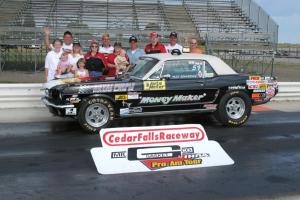|
Author
|
Topic: Engine Masters revisited
|
Dusty Kiser
Gearhead Posts: 180
From: Bethel,Oh USA
Registered: Mar 2002
|
 posted 08-11-2005 01:16 AM
posted 08-11-2005 01:16 AM
   
Has anyone seen a teardown of Kaase's cleveland yet? It's been sold for months and all the dyno info build specs etc are done and over with but Phr won't print it. I bitched at them about not having a bowtie on it, so they're ignoring it. Surely someone has published the teardown by now? I'm dying to see what his thinking was with the copper deck plates!
IP: Logged |
kid vishus
Gearhead Posts: 6405
From: middle of NC
Registered: Oct 2000
|
 posted 08-11-2005 07:46 AM
posted 08-11-2005 07:46 AM
   
I was under the impression he ran those to get more deck height out of the block so he could run a longer rod. That motor doesn't interest me much. A motor that detonates that badly down low just so it can make better power up high is pretty useless for anything except a dyno contest.
IP: Logged |
Daniel Jones
Gearhead Posts: 873
From: St. Louis, MO
Registered: Aug 99
|
 posted 08-11-2005 01:17 PM
posted 08-11-2005 01:17 PM
   
> I was under the impression he ran those to get more deck height out of the
> block so he could run a longer rod. He ran the thick headgaskets so he could run a longer stroker and smaller
bore (he sleeved the block down to decrease the bore) along with a smaller
combustion chamber. The smaller bore and smaller combustion chamber means
a smaller flame travel path allows a higher compression ratio on 92 octane
fuel. The rod length isn't that big of a deal to Kaase. He told me his
rule of thumb for rod length is "2 inches longer than stroke" which he
has used successfully on everything from 289's to IHRA mountain motors.
The big drivers for the competition are compression ratio, head flow,
and cam timing. When he won the big block EMC, Kaase had the highest
compression ratio, the best flowing heads, and a cam that worked in the
required RPM range. I haven't seen the numbers for small block EMC but
I'm told it was pretty much the same. > That motor doesn't interest me much. A motor that detonates that badly
> down low just so it can make better power up high is pretty useless for
> anything except a dyno contest. Just up the octane. On race gas, that motor wouldn't detonate.
The 2500-6500 RPM averaging does lead to some odd combinations, though.
I think it was Holdener that used a Performer RPM intake on his engine.
Though it gave up 50+ HP at peak compared to a Super Victorm, it had a
better average and the contest is awarded on averages. FWIW, I think
Kaase had the best peak and the best average. Dan Jones
IP: Logged |
Mpcoluv
Gearhead Posts: 1333
From: Charlotte NC usa
Registered: Apr 2001
|
 posted 08-14-2005 08:12 AM
posted 08-14-2005 08:12 AM
   
It WAS a motor just to win a Dyno test.
I'm sure that if he put the motor in a car, some things would change.
I think PHR never had a teardown article is becuase no major advertisers made the heads or intake on Kaase's motor. I bet if he wins with the Poncho, you won't see an article on that either.
IP: Logged |
Dusty Kiser
Gearhead Posts: 180
From: Bethel,Oh USA
Registered: Mar 2002
|
 posted 08-16-2005 09:54 PM
posted 08-16-2005 09:54 PM
   
As you said Dan, the whole concept of this competition is an engine using readily available bolt-ons (intakes, headers,heads, pan etc)that runs on 92 octane and produces the best number when AVERAGE HORSEPOWER and AVERAGE TORQUE from 2500 to 6500RPM are totalled. If you give up 25hp on bottom to get 25 on top you haven't gained a thing! Anyway, if you put a 1/2in deck plate on a 9.2 deck block, you're at 9.7in. Where do you find a bolt on intake for that deal? Besides, if the copper were used as a huge gasket, what ring/piston could you use? I'm betting he used the copper as a heat sink to try and postpone detonation. If in fact he used the small bore/long stroke concept as he did on the 385series engine, what did he do about rod/cam lobe interferance? Like I said, I'd just like to know the what, why, hows of it all. Prior to selling it, he freshened the engine and offered to drop the compression and install 1.3 ratio rockers if it were going to be used for true street duty.
IP: Logged |







 Mustangsandmore Forums
Mustangsandmore Forums

 Ford Racing
Ford Racing

 Engine Masters revisited
Engine Masters revisited


